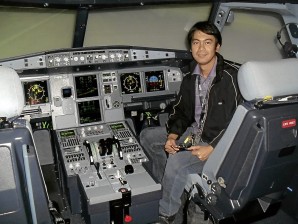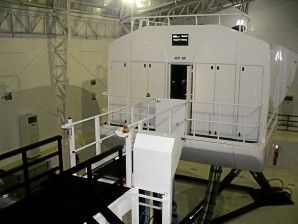Pilot training in 3D
Pilot training in the Philippines is catching up with new technology.
The WCC Aviation Co. launched recently its WCC Airbus 320 Flight Simulator Training Center near Ninoy Aquino International Airport in Pasay City. The center boasts of the latest, state-of-the-art Airbus Flight Simulator.
The $11-million training equipment is richly detailed, offering 3D images of different airport runways, cities, terrain and even weather conditions to give aviation students or retraining professional pilots an “overall realistic experience.”
The simulator replicates real-world scenarios when flying a plane, whether it is turbulence, storm, aviation obstacle, engine malfunction or poor to zero visibility.
Ground instructor Romeo Layug points out that, like the simulator, an aircraft’s cockpit is also all “automatic” now. A plane can fly and land on its own, although the pilot can still operate it manually.
Article continues after this advertisementA control board at the back of the captain’s seat in the simulator allows the instructor to change the terrain, weather condition, airport, time of day, environment, etc., depending on the lesson.
Article continues after this advertisementAccording to Layug, in the past, the simulators they used were not as detailed and automated. Most controls and instruments were for manual piloting. They also did not have the 3D view, just the cockpit’s “windshield” or window.
Layug and WCC president and chief executive officer Ramon Guico III, a licensed pilot and mayor of Binalonan, Pangasinan, agree it is much easier to fly a plane now than 10 years ago.
Layug says airplanes today even have an auto-pilot mode that takes the control from the captain or first officer and flies the plane safely, avoiding hazards, if the pilot blatantly disregards warnings issued by the automated controls.
The feature was actually added to aircraft to avoid incidents similar to 9/11.
Layug, who demonstrates how to maneuver a plane safely from takeoff to landing, while occasionally changing the conditions in and out of the cockpit, says airplanes now are a lot safer because of programmed safety measures.
Best safety ‘device’
He stresses, however, that “the best safety ‘device’ is [still] a trained pilot.”
The modern technology was developed by SIM Industries, which uses actual flight controls and instrumentation from manufacturers, such as Boeing, Airbus, Honeywell and Smiths Aerospace, to achieve the “highest fidelity” (or likeness to the real thing) possible. Even rivets for the flight deck floorboards are in the exact position, as in a real aircraft.
The simulator has an extensive airport library that can be easily updated to reflect realistic airport scenes and environments. Modeling tools allow for quick and easy creation of new airports and the repositioning of existing ones.
Inside the flight simulator, pilots and passengers experience the sensory cues delivered by the system as realistic sensations of pitching, rolling and acceleration, including flight vibrations in all directions.
Like the real thing
Observers feel how passengers and the pilot feel during a real flight. They see the runway, hear the engine power up, feel the “plane” leave the ground, fly and land. They also experience mild to severe turbulence, just like being in a real plane.
The cockpit window is actually a wide computer screen where different terrains, weather conditions, runways, etc., are projected in 3D. Smoke can even fill the cockpit to simulate engine malfunction.
“This is the biggest gamble [I have ever taken],” says Guico, referring to the purchase of the simulator.
Although actual training has not started, Guico says many students and commercial pilots are already expressing their interest in using the new training equipment. He expects the training center to begin full operation by February.
Fee is about $30,000 or P1.2 million for training for up to two months.
But Guico says they are still studying the costs and other factors involved in the maintenance and operation of the facility for possible price adjustments.
Guico also owns and operates WCC Aeronautical and Technological College and WCC Pilot Academy in Binalonan that train not just pilots but also flight attendants and aircraft mechanics. He also runs the Sky Pasada airline.
He says, in more than five years of educating aviation professionals, his schools have produced 500 commercial pilots and flight attendants and aircraft mechanics who are now working in airlines.
Although Guico does not disclose the exact fees for different courses, he says it costs about P4 million to P5 million to become a licensed pilot. The cost is a bit lower for mechanic and flight attendant courses.
He says they have students from other Southeast Asian countries, but majority of their trainees are Filipinos.
WCC prides itself in being the first aviation school in the country to operate its own airfield and to offer the Flight Navigator Trainers Procedure II in its curriculum. It is also one of only three schools that operate their own airport, airline and MRO (maintenance, repair and overhaul) facilities.
Visit www.wccaviation.com or call 9123333 for more information on WCC’s aviation training courses.


